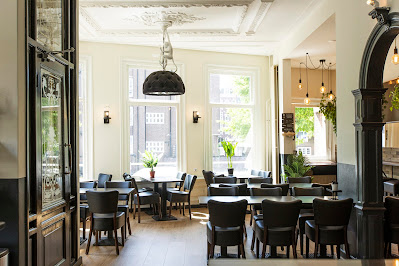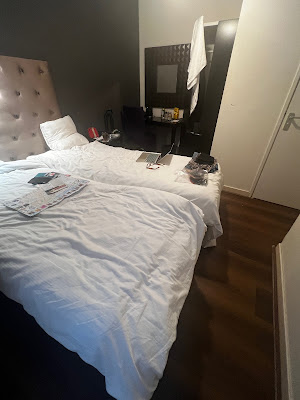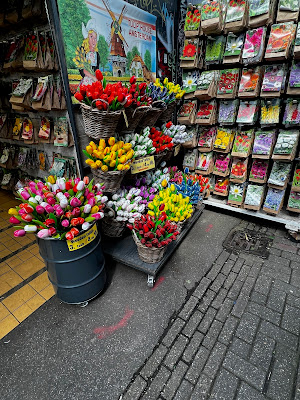After 14 days of sailing with Grand Circle Cruises on the M/V River Harmony through scenic rivers and fairytale towns, I arrived in Amsterdam on May 24, 2025—the final port.
 |
| Grand Circle 14 Day River Cruise Vienna to Amsterdam itinerary |
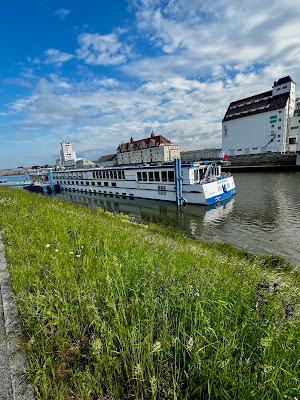 |
| M/V River Harmony |
My alarm rang the morning of May 24, 2025 at 5:30 AM, and by 7:00 AM, I was enjoying a hearty breakfast aboard the ship, ready for a full day in Amsterdam. One of the first activities on the agenda was a 90-minute canal cruise arranged by Grand Circle in partnership with GreyLine’s Blue Boat Company—a perfect way to ease into the rhythm of the city. I boarded the bus shortly after breakfast and found myself on a clean, well-kept boat, though the seating area felt a bit cramped with tight tables and chairs. While the cruise typically offers audio commentary through complimentary headphones in 21 languages, our group had the added bonus of narration from our Grand Circle Program Director—an Amsterdam native—who brought the experience to life with personal anecdotes and insider knowledge. Laminated route maps on the tables helped us follow along as we glided past the city’s iconic canal rings, 17th-century façades, narrow arched bridges, and tidy houseboats. The water mirrored the calm Dutch sky, and the captain occasionally slowed down to point out notable landmarks like the Anne Frank House and lesser-known architectural details that added texture to the city's story.
By 11:00 AM, we were back on board, just in time for lunch. Later that evening, the Captain’s cocktail reception at 6:45 PM marked the official end of our river journey. A fabulous six course Captain’s Dinner followed at 7:00 PM, but mentally, I was already gearing up for the adventure that awaited ashore.
May 25 – Public Transit Roulette and a Tiny Hotel Room
I disembarked the ship at 10:33 AM and took an Uber to my hotel, arriving by 10:51 AM. The ship docking site is Westerhoofd 200,1013 BS Amsterdam and was about 20 minutes outside the city. UBER cost for the transfer for two was €14.48 ($16.47USD at the time).
It was too early for check-in, so I stashed my bags and hit the city running.
Amsterdam’s public transportation system became the playground for the day. First, I purchased a 72 hour all transportation pass at the local GVB office at a cost of €21.50 per person ($24.46USD).
 |
| GVB Ticket Office located next to Central Station |
 |
| Ticket booth inside GVB ticket office |
 |
| Main tram stop at Central Station |
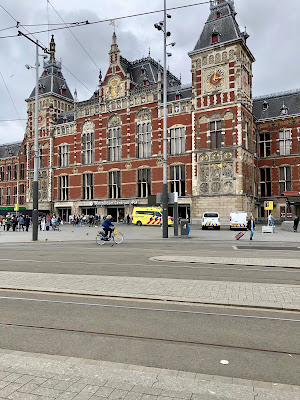 |
| Central Station |
I started at Central Station boarding the #5 tram, riding the entire loop.
 |
| #5 Tram Route |
I then transferred to #12 and explored more of the city.
 |
| #12 Tram Route |
Then it was suggested by our Grand Circle Tour Guide to take the scenic #2 tram, which lived up to its reputation with tree-lined streets and charming canal views.
 |
| #2 Tram Route |
On the way back on the #2 tram I got off at the “Museumplein” stop and walked about 3 minutes to the Cobra Cafe, it's right in the heart of the Museumplein.
 |
| Cobra Cafe |
After a short break I then made my way to the Diamond Museum Amsterdam, not quite sure what to expect—and I’m glad I did.
 |
| Diamond Museum building |
Tucked just behind the Rijksmuseum, this compact yet glittering museum walks you through the dazzling world of diamonds, from their geological origins to the art of diamond cutting. I especially enjoyed the displays that compared carat sizes and cuts, and the replica of the famous 105.602 carot Koh-i-Noor diamond caught my eye. Interactive exhibits explained how diamonds are graded. It wasn’t a long visit, but it was informative, elegant, and a sparkling surprise in the heart of the Museumplein district.
Then, another loop on the #5 bus (yes, again). I returned to the Leidseplein stop… only to get turned around trying to find the Holland Casino. I eventually found it through the Lido Restaurant and climbed upstairs—only to discover a €5 cover charge just to enter. No thanks!
.webp) |
| Holland Casino and Lido Restaurant |
Instead, I walked to Aran Irish Pub, which was bustling thanks to a big soccer match.
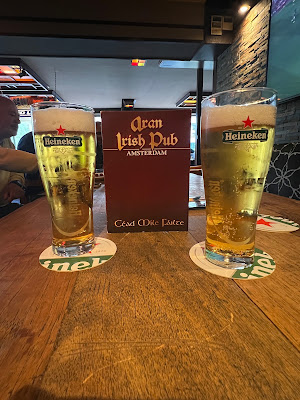 |
Later I settled in at ITA Brasserie, right beside the International Theater Amsterdam, for a relaxed dinner of burger and beer. I finally checked into the hotel around 7:30 PM.
The Quentin Amsterdam Hotel—home for the next three nights—is a historic canal house located just off the buzzing Leidseplein. Its location was unbeatable for accessing museums, transit, and nightlife, but the room itself left much to be desired. Tiny doesn’t begin to describe it—the bathroom was so compact I could barely turn around. To top it off, the elevator was broken, so we had to climb two flights with luggage. Still, the 24-hour reception and canal-side ambiance added a little charm to the otherwise modest accommodations. After a hot shower, I was asleep by 8:30 PM.
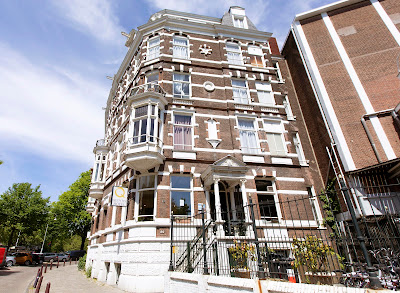 |
| Quentin Amsterdam Hotel front entrance (up the stairs) |
May 26 – Ferries, Films, and Flower Markets
I was up by 7:00 AM and enjoyed the hotel’s complimentary breakfast at 8:15 AM before venturing out again.
 |
| Breakfast area |
This time, I accidentally took bus #12 in the wrong direction—no harm done, just another spontaneous loop through Amsterdam. Eventually, I made it to Central Station and then took the F3 ferry across the IJ (pronounced “eye”) River, a quick two-minute ride, to visit The Eye Film Museum.
 |
| Entrance D to the F3 Ferry |
 |
| Inside the ferry |
 |
| View of The Eye Film Museum from the ferry |
The museum is a striking white structure—a futuristic, angular building that seems to hover over the water. Inside, the light and space immediately captivated me, with panoramic windows framing vessels gliding past on the river. The lobby’s open-air stairwell doubles as a viewing platform, where visitors can plug into one of the “listening stations” to hear immersive five-minute stories behind famous films like Run Lola Run and Chinatown.
The restaurant inside the museum is called the Eye Bar & Restaurant (sometimes simply referred to as Eye Bar Restaurant). It’s situated right within the museum at promenade 1 and offers sweeping panoramic views of the IJ River—perfect for lunch, dinner, snacks, or drinks before or after your visit.
The venue serves European-style dishes, an all-day menu featuring salads, artisan sandwiches, pastries in the daytime, and a full dinner menu in the evenings. They also offer a special "film menu" that combines dinner with a movie.
Next door was This is Holland, but I skipped it in favor of a much needed break at Eye’s café. I spent an hour or more exploring here before heading back across the river on the F3 ferry.
Once across the water, I caught Tram #14 to the Jewish Holicost Names Memorial Area—sober and humbling.
 |
| Entrance to the memorial |
I stepped into a place heavy with history and quiet reflection. A maze of two-meter-high brick walls, each brick engraved with the name, birth date, and age at death of one of the 102,000 Dutch Jewish, Roma, and Sinti victims of the Holocaust.
Above these somber walls, stainless steel panels form four Hebrew letters spelling “L’Zicharon” (“In Memory”), adding a reflective, almost ethereal layer to the memorial I wandered slowly through its corridors, running my fingers over names—each a life lost—while sunlight playing off the mirrored panels created a surreal interplay of light and shadow. It felt deeply personal and profoundly somber.
Just across the road lies the Hollandsche Schouwburg, a former theater turned deportation center and now a memorial and museum where thousands were detained during WWII. Between them, the area felt like a gently spoken lesson in remembrance—raw, heartfelt, and essential to understanding Amsterdam’s complex past.
Next—I was back on Tram #12 to the Rembrandtplein stop. I strolled the Bloemenmarkt, Amsterdam’s floating flower market.
Perched along the Singel Canal since 1862. This colorful stretch of flower stalls, built atop houseboats, offers everything from fresh tulips and daffodils to bulbs and souvenirs. Though more tourist-focused today, the market still captures the essence of the Netherlands’ floral heritage and provides a vibrant splash of local charm in the heart of the city.
After dark, I headed out to the Red Light District. It's one of those places that’s part history, part curiosity, and 100% unique to Amsterdam. The Red Light District, or De Wallen, is one of Amsterdam’s most iconic—and misunderstood—neighborhoods. Walking its narrow cobbled streets after dark was like stepping into a neon-lit blend of old-world charm and modern permissiveness. While the windows with red curtains and scantily clad women are what most people come to gawk at, the district is also home to some of the city’s oldest architecture, cozy pubs, and even a beautiful church—Oude Kerk—right in the heart of it all. The vibe was surprisingly safe and casual, with tourists strolling alongside locals, couples holding hands, and friends laughing over drinks. It felt more curious than seedy, more historical than scandalous.
I wandered both sides of the canal and eventually grabbed a late-night beer and hamburger at Pizza Pasta Bar near Oudekerksplein before catching the bus home. I was back in the room a little after 10:00 PM—feet tired, heart full.
Here’s a handy walking map and clear directions for a stroll from Amsterdam Central Station to the Red Light District:
· Distance & duration: Approximately 750 m — about a 7–10 minute walk.
Step-by-step directions:
1. Exit Central Station from the main entrance and walk south onto Damrak.
2. Continue along Damrak toward Dam Square.
3. Just past the square, turn left onto Damstraat, cross the canal via a bridge.
4. At the next intersection, turn right onto Warmoesstraat (a historic, lively street).
5. Warmoesstraat leads into the heart of De Wallen, with its famed red-lite canals and alleys
May 27 – Beer, History, and One Last Toast
The final day began leisurely. I was up at 7:30 AM, had my coffee and breakfast, and returned to the room to get a bit of work done until 12:05 PM. Around 1:30 PM, I set off for the Heineken Experience, one of Amsterdam’s most popular attractions. The closest bus or tram stop is Vijzelgracht.
Set inside the original 1867 Heineken brewery, the Heineken Experience was part museum, part interactive playground. I explored four floors of exhibits showing everything from the brewing process to the global brand legacy. There were plenty of fun touches—like learning to pour the perfect pint and using immersive video displays to experience beer from “the inside out.” My favorite part? The rooftop bar, where I sipped my fourth beer of the visit and looked out over the Amsterdam skyline.
 |
| Tour entrance and Rooftop elevator |
 |
| Original botteling machine |
 |
| Filling and labeling explanation area |
 |
| More fee samples |
 |
| Rooftop |
 |
| More free samples |
After nearly three hours at the Heineken Brewery, I headed back to my hotel stop and walked around the corner to Melkweg Café (a.k.a. "The Milky Way") for a light dinner—soup and bread for me, pizza for Marci. I enjoyed one final coffee in the hotel lobby and was back in the room by 7:45 PM, already reminiscing.
Final Thoughts
Amsterdam isn’t just picturesque canals and crooked houses—it’s movement, music, museums, and unexpected moments. Between looping bus rides, quirky museum exhibits, late-night walks, and more beers than I’ll admit, I found myself swept up in the rhythm of the city. Even the tiny hotel room and broken elevator became part of the story. That’s the magic of travel: it’s not always smooth, but it’s always unforgettable.
#River Cruise 2025#Amsterdam#Heineken Experience#Grand Circle#M/V River Harmony#Quentin Amsterdam Hotel










